- Home
- Gary Vaynerchuk
The Thank You Economy Page 12
The Thank You Economy Read online
Page 12
In the Thank You Economy, the same can be said for the big things. Most people usually think the big things are initiatives that only big companies can instigate, because it is assumed that to pull them off takes tremendous coordination and budgets. But because, as we’ve discussed, the successful navigation of the Thank You Economy requires businesses to reconsider their resource allocation, the big things are actually within every company’s reach.
What does a big thing look like? 50 Cent knows. YouTube user Pierce Ruane, a fuzzy-lipped, supremely geeky Canadian teenager whose YouTube profile lists him as Pruane2forever but who also goes by the name of Sexman, posted a YouTube video calling the rapper a media whore for promoting Vitamin Water and sex toys. When he added, “What else is he going to do—50 Cent diapers for your little gangsta?”, Ruane received almost a million hits. Rather than ignore the kid, or even take offense, 50 Cent flew him to New York City and posted a new YouTube video of the two of them hanging out together, all friendly-like, on a balcony overlooking Manhattan. The video isn’t all that exciting, but the fact that it even exists is extraordinary. 50 Cent was smart. He saw how word of mouth was spreading Sexman’s message and decided to take control of it by showing that he may be a media whore, but he’s a good sport, too. Plus, it’s going to be hard for Sexman to diss 50 Cent anymore, now that the public has seen him grinning like a kid on Christmas morning while kickin’ it next to the rap superstar.
50 Cent simultaneously nipped a problem in the bud, made a Canadian teenager and his fans smile, and reaped some good earned media. The public often forgets that celebrities are human, too. 50 Cent has gotten some negative press for bad behavior, but with this one move he humanized himself, and probably made a lot of people feel better about thinking he’s cool.
But why wait until there’s a problem? What if Hershey’s, for example, randomly chose a few people it regularly engaged with on Facebook or Twitter, and invited them and their immediate family for an all-expenses-paid visit to Hershey Park? The tickets wouldn’t be connected to a contest or any call to action—they would simply be gifts. Maybe that doesn’t sound like very good ROI—several thousand dollars in airline tickets, park attractions, food, and hotel expenses, all to make a very small number of customers happy. But that’s a very nearsighted view. The long view is in the earned media opportunities, such as when the Philadelphia Enquirer gets wind of what Hershey’s did because of all the blogging and tweeting the customers do when they share their excitement. It also doesn’t take into account what I call the RCV—relationship context value—of the initiative. A few one-time expenses can pay off in a lifetime of loyalty from the people who are touched by the company’s generosity. First off, Hershey’s has just provided its customers with one heck of a dinner story. Second, many of those customers—certainly the original fans who were online often enough that Hershey regularly engaged with them—are going to tweet and post pictures and stories even as they’re walking through the park. Then, once they’re home, when a friend says, “I can’t wait to take the kids to Disney someday,” those customers have every reason in the world to say, “Have you thought about Hershey’s? We had the best time!” and then tell their story yet again. Last, as those customers have more children, or grandchildren, it stands to reason that they would want to take those kids to Hershey Park and relive some good memories.
It’s hard for some execs to wrap their heads around the idea of spoiling customers like this, because a large number of people who run companies are salespeople at heart, not marketers; if they can’t immediately close the deal, see a unit sold or an uptick in profit, or if they don’t believe the scale of the initiative is powerful enough to move the needle, it doesn’t feel worthwhile. But we don’t do shock and awe because we’re saints. While the best thing about shock and awe is how great it can make customers feel, not to mention the pleasure we get from spreading some happiness, we do it because there is always a win. It has tremendous value and can create more business because of the additional clicks, opinions, reviews, tweets, and status updates that ensue as a result. The advantages of that kind of data collection should make sense to any business leader.
The money spent on shock and awe can have much more value than a Facebook ad or even an SEO manager’s salary. Big companies, with their big marketing and advertising budgets, can do amazing shock and awe, of course. A national electronics retailer can take the $4 million budget that it normally would have spent on an outdoor campaign, radio spot, and TV commercial, and instead use it to contact everyone on Twitter who turns twenty-one on April 21. The tweet might say, “Now that you’re of age, you need a grown-up phone. Happy birthday!” and include a coupon for 50 percent off an iPhone 4. That kind of move wouldn’t be easy, but it would be worth far more than $4 million worth of earned media.
What’s cool is that you can scale shock and awe, and still create a magical, chemical reaction. For example, what if you made a list of the twenty or thirty customers who support your business the most, and sent each of them a handwritten thank you note with a rose, or some other small gift? This would be a low-cost yet high-impact move. Maybe that sounds a little cheesy, but it’s working every day for small businesses around the country right now. You could have done something similar in 1999 and gotten a great response from your customers in the form of increased loyalty, and even some word of mouth. But the difference between then and now is the much greater distance that word of mouth can travel via blog post, tweet, picture on Flickr, and status update. The effects of shock and awe go significantly farther now, plain and simple.
Rarely does the media spend weeks following and analyzing amazing television ads or viral marketing campaigns because of how much money was spent on them. It pays attention because there’s something about the content of the campaign that is having an impact on people. It’s not the money that makes these efforts shocking and awesome, it’s the care and creativity involved. Right now, there is a fortune in word of mouth that can be created when a veterinarian sends a handwritten condolence card to clients whose pets have died, along with a book of poetry, hand-drawn sketches of the pet, and notice that a donation in the pet’s name has been made to the Humane Society. The same can be said for a hardware store owner or key employee who makes a personalized video for every customer who buys a bottle of Goo Gone, asking if the product worked, and offering additional muck-removing tips. And there could be thousands of dollars of earned media to be gained if a bakery were to send out a birthday cake to everyone on their Facebook Fan page for a whole week straight. Sure, this kind of effort would take a lot of coordination and many hours of back and forth with customers via email to gather home addresses and convenient delivery times. There would be a hefty initial up-front expense on product, too. But can you imagine the amazing earned media and RCV opportunity? These are examples of small, thoughtful gifts that add up to one amazing customer experience that can get talked and written about, and have much more value to a brand than they would have had even five years ago. What’s interesting to think about is that as incredible and possibly even impractical as some of these ideas may seem, one day they’ll be as ordinary as free shipping is to us today.
No Time Like the Present
If you are heavily into gaming or active on social networking sites, you now might be so flooded with virtual gifts that they’re starting to lose some of their impact. But remember three years ago when your friends on Facebook first started sending them? You saw that you had received that little virtual gift box with the bow and you smiled; it meant that someone had thought of you and taken the time to send you something to make you happy. Companies should be trying to re-create that feeling with their customers every day, especially now that discounts and the promise of free shipping are such ho-hum enticements that they barely factor in to most consumers’ purchasing decisions.
The reduced impact of the virtual gift, which I think will only get worse in the next five years, brings up a good question: what will happen
when people start getting fifty text messages on their birthday from every brand or company they’ve ever come across? I don’t think that will happen, because I believe that only a very small percentage of companies will seriously put shock and awe into play on a regular basis. But let’s say I’m wrong, and a lot of companies realize that they can get a heck of a lot more mileage from a single act of shock and awe than from ten billboards. Maybe 2 percent of all companies might give it a shot over the next five years. Once they saw the results, another wave of companies might follow through, but it would probably take about ten years before more than half of all the companies in the United States were actually implementing shock and awe. If that does happen, it will be time for the companies who were shock-and-awing their customers all along to readjust. According to MailerMailer’s metrics report released in July 2010, people opened their emails 20 percent less in 2009 than they did in 2007, for a total open rate of about 11 percent. Naturally, that reality has led companies to change the way they use email to reach their customers. They have also changed their approach to banner ads, because people aren’t clicking them the same way they did when banner ads first appeared on their computer screens around 1994. At that time, banner ads could see a click-through rate as high as 78 percent; today, banner ad CTR is estimated to be about 0.8 percent. Businesses invest in technology and then adjust the way they use it all the time. Why wouldn’t you expect to do the same with social media?
A lot of people are having fun registering their opinions by clicking on the “Like/Dislike” buttons they find on many brands’ Facebook pages, but their enthusiasm won’t last forever. However, just because an initiative that works today won’t necessarily work at the same level in the future is no reason to ignore the opportunities it offers you to engage with customers right now. Any data you collect helps paint a picture of your customers’ needs, wants, and interests. Though you may need to redirect your efforts when it stops working as well as it does now, your effort to connect with your customers at an emotional level should remain exactly where it’s always been—at 110 percent.
PART III
The Thank You Economy in Action
CHAPTER NINE
Avaya: Going Where the People Go
When most people think “sexy,” voice-mail software, desk phones, and routers don’t usually come to mind. Functional, effective, and, ideally, completely unnoticed by the outside world, communications systems are the Spanx that support companies so they can perform with confidence and at their best. Avaya, known for developing high-performing, even bulletproof business communications applications, systems, and services, sells some decidedly practical, unsexy products. Yet it is proving that a B2B company can use social media with the same success as a cool lifestyle or retail company.
The Thank You Economy at Work
Avaya’s main goal on Twitter has been to keep up with its consumers’ technical questions and to head complaints off at the pass. Originally engaging in one thousand interactions—replying to questions, addressing comments, et cetera—per week, the social media team now fields almost four thousand. They also developed a product that can alert the customer service department when disgruntled tweets need to be addressed. The company estimates that by adopting this method, they’ve avoided losing approximately fifty customers, at an average cost of sale to replace them of about $10,000.
One day, a tweet gave Paul Dunay, Avaya’s global managing director of Services and Social Marketing, the chance to prove that paying close attention to the consumer conversation on social networking sites could pay off big. Like all tweets, the one that changed Avaya’s game was short and simple: “shoretel or avaya, need a new phone system very soon.” Dunay replied almost immediately, “We have some highly trained techs who can help you understand your needs best and help you make an objective decision. Give me a call.’” Thirteen days later, Avaya had made a quarter-million-dollar sale to the tweeter, who then tweeted, “…we have selected AVAYA as our new phone system. Excited by the technology and benefits….”*
What Avaya Did Right
IT SHOWED UP. The $250,000 sale might not have happened if Avaya hadn’t been on Twitter. Any networking or sales expert will tell you that if you want to make the connections that will close a deal, the first thing you have to do is show up. Connections are still being made at happy hours and “On the Horizon” breakfasts, but they’re increasingly being made online, too. Avaya showed up where few others, if any, in its niche were even looking, and it walked away a winner. Avaya was aware. Avaya cared. Avaya closed the deal in thirteen days.
Too many B2B companies are still avoiding social media because they don’t believe their customers are part of the social media demographic. Over 60 percent of Americans use social media (and many more by the time you read this); a sizable portion of those users surely makes B2B decisions. By now, it seems pretty obvious that anyone old enough to use a computer should be considered part of the social media demographic.
IT SHOWED UP FIRST. The companies that successfully make the move into social media ahead of their competitors not only gain in market share and earned media (for example, Burger King estimates that it earned back over $400,000 in earned media from a less than $50,000 investment in its BK Whopper Sacrifice, a Friend Facebook campaign), they also gain in brand equity. They are recognized for their vision and innovation, for being smart and tech savvy. Such qualities can go a long way toward leading someone looking for B2B opportunities to believe that working with that kind of forward-thinking company is a winning proposition. Avaya’s efforts in providing outstanding customer service have been rewarded two years in a row with a J. D. Power Award for Outstanding Customer Service Experience, as well as an induction into the Technology Services Industry Association STAR Awards Hall of Fame. Both honors should carry a lot of weight within Avaya’s industry.
IT REMEMBERED THAT BEHIND EVERY B2B TRANSACTION, THERE’S A C. The C in a B2B exchange—usually a purchasing manager, a purchasing agent, or a buyer—wants the same thing as any other consumer when making buying decisions: outstanding products and service, and the reassurance that someone is thinking about how to best meet the person’s business needs. When deciding whether to try a new brand, purchasers usually talk to friends and colleagues they trust. Before, they might have made a couple of phone calls or sent out a few emails. They might have floated some questions to a friend while sharing Cracker Jacks during the seventh-inning stretch at a baseball game, or panted them out during a run on the treadmill. Today, though, they can get feedback and advice a lot faster and from a greater number of sources by simply posting their thoughts on Facebook or Twitter. More and more of the individuals who make important B2B decisions, or any consumer decisions, are using those platforms to get the advice and feedback they need. For example, the social media department caught an opportunity to provide some basic support to a frustrated client. The client was so impressed with the service he received that he became a vocal advocate. To thank him, the company decided to send him some Avaya swag. When they contacted him for his mailing address, they discovered he was the CIO of a major investment bank in New York. Every interaction matters. Every relationship has value.
CHAPTER TEN
AJ Bombers: Communicating with the Community
If you go to the AJ Bombers website, you can see a long list of tweets scrolling down the right side of the page. There’s a lot of talk about burgers. The Caesar seems to be particularly popular. People want to know how they can get a burger card. At one time, there was a discussion about who’s gone electric shaver over blade. The conversation seems to be endless between AJ Bomber fans, maybe because AJ Bombers, a Milwaukee burger joint started in March 2009 by Joe and Angie Sorge, makes it a priority to keep the conversation going.
Joe, AJ Bombers’ front man, has been doing his best to keep people talking from day one. First, he and his wife opened a restaurant that critics lauded for its food and ambience in one of those cursed “revolving door�
� locations where chefs’ dreams of culinary stardom usually come to die. They did it by keeping their prices recession proof—$4.50 for a basic cheeseburger with lettuce and tomato, $7.50 for the Bomber, the same but stacked with a fried, stuffed mushroom. They did it with an awesome peanut delivery system, in which bartenders load up colorful bomber airplanes with peanuts, and then launch them on rails attached to the ceiling where they travel across the restaurant to smack into a target on the wall and dump their cargo into a bin. And they did it by figuring out that the best way to get customers to care passionately about their business is to let the customers help them build it.
The customers have input over almost every aspect of the restaurant brand. They build menu items, determine price structures and hours of operation, suggest promotions, and even guest bartend for charity events. How does Joe Sorge dare give such control of his brand over to his customers? Two reasons. The first is that one-to-one relationships make life more fun. The second is that in a Thank You Economy, it pays off. Big.
Knowing his customer base has always been a priority for Sorge. The idea that you have to create a welcoming atmosphere in a restaurant is a no-brainer, but at AJ Bombers, online customers get as much attention as anyone sitting at a four-top.
* * *
The last line in that last paragraph is in bold because it’s that important. I am convinced that the biggest disconnect for business leaders lies in their understanding of how they should treat customers they meet face-to-face, and how they should treat the ones they meet through their computer, iPad, or phone. There should be no difference. Customers or potential customers can have some powerful emotions when they’re considering using your product or service. They’re imagining what it might do for them, what they could make with it, how it could make their life or job easier, how it could affect their relationships or family. Those emotions exist whether the consumer is interacting with you face-to-face, or via chat, IM, blog, Twitter, or Facebook, or in a forum.

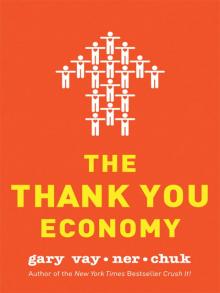 The Thank You Economy
The Thank You Economy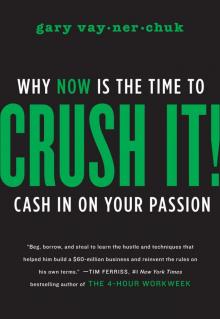 Crush It!
Crush It!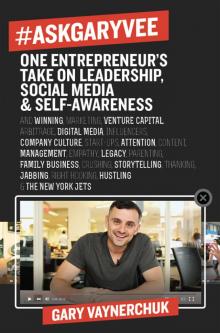 #AskGaryVee
#AskGaryVee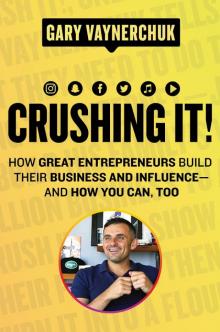 Crushing It! EPB
Crushing It! EPB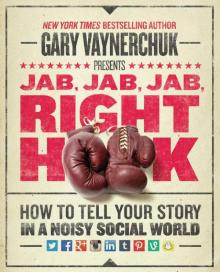 Jab, Jab, Jab, Right Hook
Jab, Jab, Jab, Right Hook